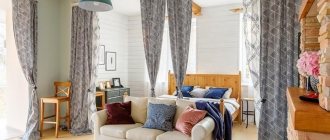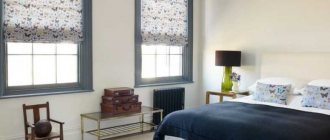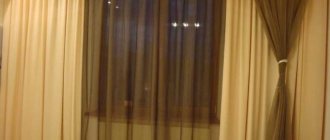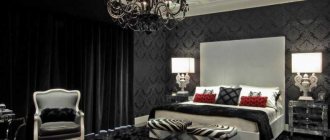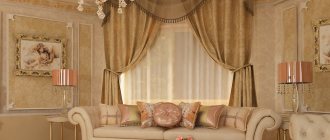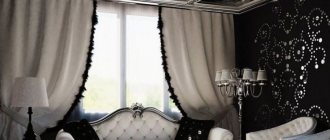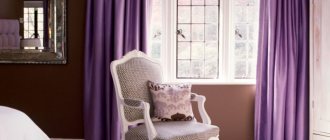The classic window design is considered to be curtains hung symmetrically on both sides: this technique is suitable for any room. But in some interiors, multi-level curtains assembled on the side of the window opening look much more interesting. This adds dynamics to the room and also emphasizes the modern design of the apartment.
Peculiarities
Asymmetrical curtains are used in the following cases:
- For windows of non-standard, unusual shapes: arched, triangular, trapezoidal, bay window. You can decorate them with an oblique strip of fabric moving to one side.
- To give the interior dynamics and liveliness. Asymmetry can manifest itself in color, length, patterns.
- Multi-layer irregularly shaped curtains made of lightweight fabrics look very stylish. You can even do without additions and decorations; they themselves will look modern and attractive.
- If there is a need to adjust the shape of the room. An elongated rectangular room will be transformed if you hang asymmetrical curtains of different lengths.
- If the window is offset from the center of the wall, an asymmetrical bias-cut curtain will visually correct the proportions.
In a narrow room, you can visually correct the proportions by using a classic draped curtain and a wide asymmetrical rigid lambrequin covering the entire width of the wall as window decoration.
Such curtains are not used:
- In very small rooms they can look heavy.
- In a room with an abundance of objects and decorative elements. They themselves serve as a bright accent - in such an interior they can create a feeling of overload.
- In classic interiors they can ruin the overall concept.
- For high-tech and minimalist styles, asymmetrical curtains can add dissonance.
This is interesting: Mirrors opposite each other: “yes” and “no” (22 photos)
Features of arranging a room with an off-center window to bookmarks
If you are lucky enough to become the owner of a living room interior in which the window is not located in the center of the wall, then do not be alarmed. A little ingenuity and imagination, the right competent approach to the development of interior design, and you will turn a seeming flaw into a highlight.
In modern houses you can often encounter a rather strange phenomenon - the window on the wall is not located in the middle, but is shifted to one side. Often it is located almost in the corner, with a slight indentation from the edge. What should the owners of such a “miracle” inherited from developers do?
A room with a window not in the center of the wall may seem unwelcoming and unfriendly at first glance. A window can create an optical illusion by making a room appear heavier on one side, giving it a lopsided appearance. Professional interior design advice can help you balance the visual weight of your window to create a pleasing, asymmetrically balanced space in the room.
Possible options
Asymmetry of curtains can be expressed in various forms:
- Using parallel curtains of different lengths. The option is most convenient for windows combined with a door to the balcony.
- Instead of two parallel curtains, use one wide canvas, securing it with a tie on one side. You can match it with an asymmetrical lambrequin.
- A curtain cut diagonally to cover only part of the window. On one side the curtain reaches the floor or window sill. This option is best suited for kitchens.
Not only curtains can be asymmetrical, but also decorative elements: swags, bells, frills, fringes.
- Multilayer composition: curtain, lambrequin, curtain fabric. Consists of several parts of different shapes and lengths.
- Hanging curtains on two adjacent windows on opposite sides in a mirror image.
- Color asymmetry: you can combine curtains of the same length in different colors, plain and ornamented.
- Asymmetry using a pattern: on one curtain there is a large one, on the other there is a small similar one, or one pattern, but in different colors.
- Two parallel canvases of different widths.
- Two parallel curtains assembled in different ways.
- A set of canvases with an asymmetrical lambrequin. The lambrequin can be cut diagonally, changing the length. It can be in the form of beautiful folds, falling from one corner of the window to the other.
- Asymmetrical composition of transparent fabrics: the usual one is tightly complemented by an asymmetrical curtain on one side. As an addition, you can use roller blinds (day-night, with electric drive).
Triangular shaped windows
Architects rarely design triangular windows, so the design of this design can cause certain difficulties. The curtain can be fixed to a thin tubular cornice located on one of the upper sides of the triangle. The curtain panel is draped on the opposite side and secured with a clamp.
Attention: you should make sure that the hooks on which the curtain is attached do not slide down the cornice, otherwise the product will not hold its shape. You can use tulle on individual hangers for these purposes.
The design consisting of two cornices located parallel to the upper sides of the triangle looks interesting. Thin felt felt of contrasting colors is hung over them and fixed crosswise.
Note: for small windows it is better to purchase special mini-curtain rods with a small rod diameter.
If there is no need to adjust the position of the curtains in the room, the triangular window can be decorated with tulle on the cornice, repeating the shape and angle of connection of its two upper sides. This design looks impressive in the attic, occupying the entire end wall of the room. The tulle for it will have to be sewn to order, since the upper edge of the product must be made at an acute angle.
Another way to emphasize the interesting shape of a window is to install a short straight cornice above it, and curtain it with light, wide tulle, fixing its lower edges on both sides of the base of the triangle.
Tip: if you combine a forged cornice and light colorful curtains decorated with tassels, you will get a beautiful design in the Provence style.
If a room with a triangular window needs a lot of sunlight, you can decorate the opening with small curtains that form light draperies around its perimeter. To prevent the canvases from cluttering the structure, they are fixed on the sides of the window using tiebacks.
It is very convenient to use blinds on non-standard windows. For a triangular opening, these can be vertical structures, the elements of which are attached to the cornice on special movable runners. This makes it possible to adjust the position of the slats and rotate them using a cord.
Please note: blinds can be positioned at a maximum angle of 55 degrees.
Fabrics
When using asymmetry in only one part of a set of curtains, dense expensive materials look especially advantageous:
- Tapestry.
- Velours.
- Velvet.
- Jacquard.
- Brocade.
- Fabrics with gold thread.
Asymmetrical curtains perfectly hide architectural imperfections and add dynamism and originality to the design of the premises.
For asymmetrical curtains on small windows, light transparent fabrics are used:
- Organza.
- Tulle
- Chiffon.
- Batiste.
- Net.
- Veil.
Rules for choosing multilayer light protection systems
Multilayer models provide effective light protection for the room, complement and decorate the interior.
Classic to the floor
Such curtains look solemn and elegant when combining two layers - curtains made of expensive fabric (satin, jacquard, brocade, velvet) and curtains made of translucent or transparent material (organza, veil, chiffon, tulle). One layer is plain, the second is with patterns. An effective solution is a lambrequin, which can be soft or hard (bandeau). These options are often used for living rooms and bedrooms designed in the “classical” or “baroque” styles. It is advisable that one layer matches the color of the wallpaper, and the second – the textiles in the room or accent decorative elements.
Did you like the curtains? You can order the same in the Living Room section
Lifting models – roll, Roman, French
In the styles of minimalism, loft and other modern interior solutions, practical lifting systems are popular - roller-type open and closed types, Roman models. Such products can be used independently or in combination with classic long curtains. French systems, more luxurious than the laconic “Romans”, are most often self-sufficient.
Did you like the curtains? You can order the same ones in the Roman blinds section
In what cases is it better to avoid using asymmetrical curtains?
But there are also situations when it is better to refuse asymmetrical curtains:
- In too small spaces. Such curtains look out of place in tiny rooms and only overload the interior.
- In rooms crowded with furniture and interior items. The design of such a room is already oversaturated with details; asymmetrical curtains will simply get lost against this colorful background.
- Specialized, official premises are not the place to experiment with textile fantasies. Even in the private offices of doctors or private consultants, not to mention government and financial institutions, such curtains are inappropriate, since people come precisely for stability and confidence. Therefore, even a hint of frivolity can damage the image of a company or institution.
- In places where there is too much light, movement and events. For example, the room of a hyperactive child is not the best place for asymmetrical curtains. And in kindergarten groups, school classes or in the living room of a large family, such curtains would not be appropriate.
- In prim classic interiors that are close to authenticity, fantasies on the theme of asymmetry will only disrupt the holistic design image. The same applies to very old interiors. It will not be possible to revive them only with the help of asymmetrical curtains; you will have to decide on some other alterations.
In order to emphasize the dynamics of the created image, it is important to choose the right color scheme for the curtains.
- If you have chosen one of the curtain elements as an object of asymmetry, then you do not need to highlight it with color. It would be better if it remained in the same tone as the main color scheme.
- Having settled on curtains of different lengths, it is wiser to also make them the same color, then they will look like a single complex, and not dissimilar elements. If you decide to make a transparent curtain asymmetrical, then you can safely order external curtains in a contrasting color or pattern.
- Have you settled on the option of color asymmetry, when you have curtains of the same length and design, but different colors? Great. The main thing is to choose colors that are harmonious. In order not to make a mistake in your choice, you can use the advice of experienced designers and select combinations according to Itten’s color wheel. Colors located opposite each other in a circle will give you contrasting and energetic combinations: red - green, orange - blue. For a more subdued mood, use shades four colors apart from each other. For example, lilac - yellow or lilac - blue.
- Do you want to create an asymmetrical look, but don't want curtains in different colors and sizes? You can choose the same curtains, but make them asymmetrical using a pattern. On one curtain it can be large and noticeable, but on another it may be completely absent. You can choose a pattern on both curtains, but on one it can be large and on the other small, or you can choose patterns of different colors.
As you can see, asymmetrical curtains can be very diverse in both shape and color. With their help, you can not only change the geometry of a window or the atmosphere of a room, but also create an original, creative interior with just a few touches.
Everyone knows what symmetry is. In most interiors, everything is arranged symmetrically. But sometimes in an interior “laid out on shelves”, you want something original. Asymmetrical curtains, lambrequin or tulle will help here: they, no worse than mirrors and lamps, can transform space, create illusions, and emphasize the originality of the interior. In addition, you can make a simple model of them yourself. The opportunity to create something extraordinary appears when you need to make curtains for irregularly shaped windows. It is precisely these windows - asymmetrical, beveled and oblique - that will be discussed in this article.
Such window decoration is also an excellent option for non-standard cases in the layout of premises: in attics, on windows with balconies, when the window opening has a polyhedron shape or is located on the ceiling.
Another option when asymmetry can save space is a window in a small kitchen, located closer to the corner of the room. Due to space saving, it sometimes turns out to be partially blocked by household appliances or furniture, and it will not be possible to hang a curtain in a darkened corner. A simple option is suitable here: a bias curtain, lambrequin or curtain, which are easy to sew with your own hands.
What is asymmetry?
“Fixing” windows with curtains
“Fixing” windows with curtains
Blinds, curtains and drapes not only decorate the window, but also correct its imperfections. Low ones are made higher, narrow ones are made wider. You just need to know the secrets of decorators. We will look at some of them today.
How to make a window wider? Order the cornice slightly longer than the window. At least 20 cm on each side (in total - 50 or more). Accordingly, the curtains should start from the edge of the cornice. Thus, firstly, the window will seem wider, and secondly, with the curtains drawn, more daylight will enter the room.
If in a small room the tulle hangs strictly along the window, or extends onto the walls only a few centimeters, the small room looks even smaller. In this case, you should lengthen the rod, add thick curtains to the tulle, which, when opened, will be located against the background of the wall, and the window will expand. The photos illustrating the design of window curtains show that lengthening the cornice and the combination of tulle and thick curtains visually expands the window.
How to make a window taller? If your window is located low, at a great distance from the ceiling (30 cm or more), and the height of the ceiling is small, then you cannot hang the cornice directly above the window: visually you will lower both the window and the ceiling. Raise the curtain rod and curtain as much as possible. This will happen if you choose grommets from all types of fastening (decorative rings that strengthen the holes in the upper part of the curtain into which the curtain rod is threaded). A small “comb” is formed above the eyelets; this is what “lifts” the curtain, so that its top is right under the ceiling.
With the same success, you can make curtains with a drawstring (it also forms a “comb”). The distance of the curtains from the floor also matters. They should be as long as possible. Short curtains up to the window sill shorten the window.
If the window is located low, at a considerable distance from the ceiling, decorating the windows with curtains will help straighten the situation - the photos show the curtains raised to the maximum, reaching the floor at the bottom.
How to make a window smaller? Sometimes it becomes necessary to visually reduce windows and lower ceilings.
For large windows, it is worth using active colors for curtains. Find a fabric with a pop of color (such as an abstract pattern) and make the curtain in the shape of the window. The result will be a stained glass effect. Bright inserts at eye level will also give a good result. They will distract attention from the high ceiling. The design of the curtains will allow you to visually shorten a window that is too tall. Just as it is better to wear a blouse with a skirt on a long figure, not a dress, so it is better to “break up” a tall window with color or texture. How can we not remember about lambrequins? Decorate the curtains with lambrequins with frills and tassels. The eye catches the brush and does not catch the space..
Curtains with lambrequins, frills and tassels will visually reduce the vertical size of the window.
Decor of a wide low window. The window of a standard panel house can also be decorated in a very interesting way. Panel curtains, roller blinds, multi-tiered curtains made of thin fabric that allows light to pass through are suitable for it. You can combine textiles and panels, textiles and rollerballs. If you don’t want to close the window, hang two textile triangles that overlap each other, and tie stones and shells to the ends that fall to the floor: they will weigh down and fix the triangles.
Color palette and designs: do not create dissonance
Don’t try to collect all the beautiful textiles that you have stored for the room into one ensemble on the windows. Instead of an “interior symphony” you get an “amateur artistic performance”. Here are some tips on how to maintain a sense of proportion when decorating a window with your own hands.
If the window composition as a whole is symmetrical, and there is only one “wrong” element in it, it is preferable to highlight it with color, or choose a darker tone.
It is advisable to leave two curtains of different lengths the same color. But in combination with identical curtains and an asymmetrical curtain, the color of the former can be contrasting.
In multi-layered ensembles it is better not to be colorful. If they consist entirely of transparent fabrics, let them all be plain. Choose shades based on how they look when placed on top of each other. If the composition is completed by curtains or a lambrequin, they can be with a pattern, but the tulle part remains monochromatic.
Avoid combining two fabrics with different patterns. Such combinations are only possible for a professional.
Wrong curtain width
Problem
When buying or ordering curtains, many focus on the width of the wall, for example, 200 cm. And they completely forget about folds, which significantly reduce the size of the finished canvas.
As a result, two curtains do not reach each other in the center of the window and the sun or light from a street lamp constantly enters the room.
Solution
The width of the canvas is determined by the length of the cornice and the type of desired curtain fastening. To calculate how much fabric you will need, you need to know the gathering factor
.
INMYROOM Tip:
When calculating the width of the curtains on both sides, you need to add another 10 cm to the hem of the sides if you plan to sew the curtains yourself.
Colors
When using asymmetrical curtains, achieving harmony requires a sense of proportion:
- An asymmetrical, irregular element in such curtains can be highlighted with color or a darker tone can be chosen for it.
- It is better to use two curtains of different lengths of the same color.
- In multi-layer structures, variegation should be avoided. If the curtains are completely transparent, it is better to use plain ones, and choose the shades so that they look good when layered one on top of the other.
- If the composition includes a lambrequin and porters, they can be patterned, but the curtains remain plain.
- It is inappropriate to combine fabrics with different patterns and patterns (floral print with geometric pattern).
- In combinations with identical curtains and asymmetrical curtains, the color of the curtains can be contrasting with the curtains.
If color asymmetry is used, the main thing is to choose harmonious combinations of tones. Fashionable contrasting combinations:
- Raspberry with gray.
- Red with beige.
- Chocolate with cream.
- Gray with green.
- Blue with brown.
Cornices used on non-standard shaped windows
To frame windows with a curved top edge, metal or plastic flexible profile structures are used. They can be with internal (hidden) or external rail. The canvases are fixed on them using hooks or Velcro adhesive tape.
Various shapes of the opening can follow tire curtain rods with rotating elements. They can be rotated 90 degrees and cut to the required length. Such designs are suitable for framing bay windows.
If it is difficult to achieve a perfect repetition of the window shape using a finished cornice, you can replace it with hooks. They are fixed in the wall along the perimeter of the frame and curtains are hung from them using loops. These fastening elements can be of different colors (white, black, silver, bronze), which allows you to create a beautiful harmonious/contrasting combination with curtains/tulle.
When decorating a room in country or eco-style, you can do without cornices altogether. An ordinary tree branch will serve as a fastener for curtains. It can be varnished, painted white or black - such an element of window decor will certainly attract attention.
Note: curtains are attached to the curtain rod using ties
We sew asymmetrical window decorations with our own hands
Let's try to sew the flirty model shown in the photo. This is one of the options suitable for a kitchen with a window in the corner of the wall.
The bottom fabric is very easy to sew. Determine the length as desired, take approximately double the width (for assembly). The bottom cut is finished with a tight zigzag stitch or a roller stitch, if your machine has one. A curtain tape is attached to the top edge.
For the most draped curtain, you will also need at least two widths of fabric (if you want a more fluffy gather, take an even wider fabric). The length is also arbitrary (in the photo - up to the window sill).
We process the upper and lower cuts in the same way as the first option. Now we begin to create the “highlight” - the oblique drapery. It is obtained by tightening a cord stretched along an oblique line.
To determine its location, you can hang the curtain on the curtain rod and secure it with a rope or tape in the right place. Mark the beginning and end points of this line from the wrong side, then lay out the canvas and connect these points from the wrong side with chalk or soap.
The drawstring for the cord itself can be designed in different ways:
- Sew bias tape along the line and thread the rope through it. Connect the ends and secure them to the outer hook, pulling them to the desired amount.
- Instead of trim, you can sew the same curtain tape - the gathering will be uniform.
- Thread an elastic band into the drawstring, which is used in belts to regulate volume - it has holes for buttons. By sewing a button on the inside of the top edge of the gather, you can also change the size of the gather.
Sewing such a curtain with your own hands is not a difficult task. All that remains is to iron the product.
Asymmetrical curtains are a difficult element of the interior. But, chosen correctly, they can change it beyond recognition.
Blinds
Despite the fact that many people associate blinds with administrative premises, for houses with non-standard windows they can become an escape from the sun and prying eyes. Wood, plastic, aluminum and fabric are used to make them. Blinds for non-standard windows can be made from individual strips (slats) placed vertically or horizontally. Depending on the shape of the window, the slats are fixed in order of increasing or decreasing their length. The guide for vertical blinds can easily be fixed at an angle to the floor surface. Horizontal blinds can be attached either to the window frame or under the ceiling.
Another option suitable for unusually shaped windows are pleated blinds. They are made from solid fabric and slide apart along guides. Most often they are made of several elements, in accordance with simple geometric shapes into which the window can be divided. Separately, a rectangular movable part and a triangular or semicircular fixed part are made. Modern technologies make it possible to make fully sliding pleated blinds for arched and even round windows that open like a fan.
Materials for curtains on one side
The choice of material begins with determining the style and features of the room. To decorate the curtains that are located next to the window, dense and thin materials are used.
The first group includes:
- brocade;
- silk;
- velvet.
Among thin fabrics, modern designers most often use:
- taffeta;
- muslin;
- perforated metallized materials.
When sewing side curtains, you need to correctly take into account the transparency of the material. They are presented in the following forms:
- Transparent fabric. It can be painted in different shades. For example, white, yellow, green, pink. The material transmits light well. Therefore, it is best to use this model range in apartments located above the 5th floor. Transparent fabric is ideal for decorating kitchen windows.
- Fabric that diffuses light. The material does not completely transmit daylight, eliminating the room from direct rays and sunbeams. It is optimal to place curtains in rooms whose windows face north and east.
- Material that does not transmit light. It is a dense, opaque fabric, most often in dark shades. Velvet or brocade is usually used to decorate curtains for one window. Light does not pass through matter due to its special structure.
Sheer and diffuse fabrics are typically used for functional drapes. With their help, original ideas and compositions are embodied, which later serve as window drapery. Blackout curtains are usually used for static curtains. They bring a special charm to the room.
Kitchen
In any, even the most beautiful kitchen interior, practicality still comes first. There is often not much space in the kitchen, so the best options for decorating windows would be:
- curtains with a lifting mechanism - Roman, roller, with tulle, curtains or by themselves;
- dimout curtains;
- short or arched tulle;
- crossed curtains tied with tiebacks;
- cafe style curtains;
- Austrian curtains.
Fabrics for them must be durable, reliable and able to withstand more than one wash. Of thin materials, organza is considered the best, and of dense materials, linen.
Types of premises where they are used
Curtains with asymmetrical details and cut are used:
- In offices, agencies, studios, offices - models of bright contrasting colors made of practical fabrics.
- In cafes, restaurants, hotels , classic draperies combined with asymmetrical lambrequins and draperies are especially popular. The fabrics used are dense, flowing, glossy fabrics.
- In stores of different directions there are shortened versions of bias-cut curtains in calm shades.
Curtains for the bedroom - new 2016:
(0) comments
Recommendations for design
Asymmetrical curtains are hung in rooms of various widths, lengths, heights, and purposes. The main tasks of curtains on one side:
- add dynamism to the interior;
- hide flaws in the finishing;
- mask the asymmetry of a window or room;
- play with complex openings (loggias, too narrow, wide windows).
Advantages of curtains on one side:
- savings - you will spend less on materials and seamstress work;
- ease of use - closing, opening, washing, ironing is much easier;
- air circulation - nothing interferes with ventilating the room;
- access to the window sill - if you use a curtain without tulle, you can take or put something on the window without unnecessary movements, without giving up the cozy curtain altogether.
One-sided curtains on different window openings will look different:
- The balcony opening is often played up by placing a long curtain on one side and a short curtain on the other.
- Two windows on the same wall will look good with one-way curtains.
- In addition to a Roman or roller blind, hanging asymmetrical tulle in a neutral color is enough to add coziness to the room.
- When there is a tall cabinet, refrigerator or other furniture on one side of the window, a one-sided curtain is a real salvation.
- An asymmetrical lambrequin will complement the composition on one side. The combination looks harmonious when it becomes longer closer to the curtain.
- The curtain on one side can hang freely, drape, or hang on a tieback - it all depends on the chosen interior style.
- When choosing a violation of symmetry, it is good to support it in other details: furniture arrangement, image on the wall, ceiling, etc.
The photo shows an option for draping two windows
How can you drape?
There are a great variety of drapery options, it all depends on your goals and visual preferences.
Standard for assembly use:
- curtain tape;
- wall supports;
- magnets;
- hairpins
The easiest option is to assemble the curtain in the center, moving it to the side of the nearest wall. You can attach it to a clip, a magnet, or a hairpin.
You adjust the amount of sagging yourself - the more theatrical option you want, the greater the difference between the width of the upper and lower parts should be.
In minimalistic and modern interiors, such assembly is not needed at all - just move the curtain to one side, forming soft folds along the entire length.
The photo shows a classic lift with a tassel
Sewing asymmetrical curtains
Beautiful, fancy-shaped curtains for the kitchen can be easily sewn, saving time on searching for the required model in stores and money on its purchase.
Photos of beautiful curtains made by yourself.
The tulle part of this curtain is created in several stages:
- Decide on the length you need. Multiply the desired width by about two so that there is enough fabric for gathering.
- Finish the bottom edge of the curtain.
- Sew ribbon or braid for curtains along the top edge.
Making the main curtain with your own hands:
- Also measure double the width. You can increase it depending on how lush the ruffles you want to see in the finished product.
- The length of the curtain depends on your preference. For the kitchen, curtains just below the window sill are suitable.
- Finish the edges of the curtains.
- Pull the braid diagonally and tighten it so that an oblique angle is formed.
Next, you can complement your curtain with elements also created by yourself. For example, you can decorate the braid that holds the curtain together with ruffles or ribbons. Here everything depends only on your imagination.
So, the original curtain with your own hands is ready!
This asymmetry will give any room a light, flirty mood. This design fits particularly organically into the interior of the kitchen. Their playful attitude will help you create real culinary masterpieces in your kitchen.
Curtains made by yourself will make the design of your windows completely unique and inimitable.
You can also create asymmetrical curtains for your living room, bedroom or nursery with your own hands.
In an effort to create beautiful and original curtains for the living room, the most unexpected idea may arise. For example, sew asymmetrical curtains. Such curtains themselves look quite attractive and interesting. But the question arises:
Would such curtains be appropriate in the interior of a room for receiving guests or would they make its decoration look ridiculous?
To answer this, we propose to deal with what is called curtains with irregular symmetry. What style can they be and in what cases can they be used to decorate a window? And in which cases should we abandon such an idea?
How do they look in the interior of the rooms?
Before we move on to analyzing individual rooms, here are a few rules that should be followed in any interior:
- In small spaces, abandon dark dense fabrics in favor of light, flowy ones.
- Use additional window shading (blinds, pleated blinds, rollers) if the windows are east or south.
- Lambrequins and complex designs will make low ceilings even lower.
- In rooms with a lack of light, warmish shades look good, in sunny ones - cold ones.
Photo of asymmetrical curtains in the kitchen
A curtain on one side is most often hung in the kitchen - usually the left or right wall is occupied by a refrigerator or a pencil case. And the opposite side remains empty and requires decoration.
The classic option is a canvas across the entire width of the window, picked up on one side. Its advantages:
- easy to open and close the window opening;
- does not visually reduce the size of the room;
- prevents sunlight from entering in the summer heat;
- protects from prying eyes.
A plain, laconic curtain for the kitchen is an excellent option for a small area. She doesn't overload, but copes with her responsibilities.
If the kitchen is spacious and you want to decorate the window opening in a special way, try on a set in a classic style. For example, a long curtain hangs on one side of the window, a short tulle or airy French curtain hangs on the other, and on top there is a threshold made of the same fabric as a one-sided curtain. The same option is suitable for a kitchen with a balcony.
Have you made a dining table or an extension of your work area from a window sill? Combine a short one-way kitchen curtain with a pleated, blind or roller model that attaches directly to the glass. This way you won’t need to close the fabric curtain from the outside and the window sill will always be open.
In the photo there is a one-sided curtain with a tieback
Curtains in the living room on one side
Curtains on one side for the hall are usually used for window openings with a balcony door, double windows on 1 wall, asymmetrical layouts.
A one-sided curtain is often combined with transparent chiffon or organza tulle. Without this detail, the main room of the house does not look so cozy. Tulle is hung straight across the entire width of the cornice.
There are several options for the curtains themselves:
- A curtain with a tie on one side, occupying the entire width of the opening. It does not look short, unlike curtains that start from the center and go to the side.
- Two curtains at different levels, tied to one side.
- A curtain and a lambrequin made of soft fabric to match each other, smoothly flowing to the corner.
One-sided curtains do not have to be picked up in the center; by adjusting the height, you can change the design of the room:
- The fold located in the upper part, closer to the ceiling, creates the illusion of high walls.
- A magnet in the lower third of the curtain grounds the room, ideal for high rooms.
Bedroom ideas
The first thing you need to pay attention to is the dimensions of the room. Curtains on one side in a large bedroom can be dark, thick, hanging heavily to the floor and even lying on it. They are usually combined with tulle; a tieback with a large tassel will look impressive on the curtain itself.
If the room is small, there are several options:
- A roller blind or blinds on the window itself will protect from sunlight, and airy, light one-sided tulle will create a feeling of comfort.
- A short decorative curtain to the window sill made of blackout fabric in a white or pastel shade and a long one to the floor will decorate the opening with the balcony door.
- A plain straight-shaped curtain made of natural linen or cotton will not protect from the sun, but will become a stylish accent of the interior. Suitable for dimly lit bedrooms.
Consider the location of the curtains relative to the ceiling height:
- an invisible ceiling rail will help make low walls a little higher;
- A pipe cornice with curtains on rings, ties or grommets will become an advantageous accent in rooms with a height of 270+ cm.
The photo shows light two-layer curtains
Examples in the interior of a children's room
Bias curtains are often used in children's rooms. Their main advantages:
- bright design element;
- excellent penetration of light and fresh air;
- adjusting to the layout if some of the walls adjacent to the window are already occupied.
A composition with one-sided curtains looks harmonious when the headboard is located between two windows, and they are hung with bright curtains collected from the bed.
A curtain hanging from the edge of the window-sill table will highlight the workspace and effectively zone the room.
To prevent your child from waking up at first light, complement the bright curtain with a thick Roman or roller curtain. Or, on the contrary, let the Roman curtain be bright, and the outer curtain be plain, neutral.
Pay special attention to the choice of accessories: for children there are interesting holders with images of their favorite characters, in the form of soft toys, etc. They can easily be replaced with more universal ones as the child grows up, while saving on new curtains.
The photo shows an example of combining three materials
When asymmetry is inappropriate
A non-trivial approach to curtain design can radically change the interior, focus on its advantages and neutralize its disadvantages. Of course, when choosing such decor, it is necessary to take into account the size and shape of the window opening, as well as the layout features and functional purpose of the room. Therefore, it is necessary to decide whether asymmetrical curtains are suitable individually for each case, however, general recommendations for their use also exist.
Let's consider the main ones:
- Curtains for the living room are often an accent element around which the entire interior is formed. In small living rooms, it is not recommended to break their symmetry, since visually the room will seem overloaded. At the same time, the same curtains in the kitchen, even if small, will be very useful, since they will free up useful space on the windowsill and the area under it.
- Asymmetry on the window will definitely be unnecessary when the setting already has a large number of small details and several accents. Even curtains sewn from nondescript fabrics will attract attention with their non-standard shape.
- Asymmetrical curtains for a bedroom or children's room do not completely shade the space and their design will not correspond to the functionality of these rooms. If you still decide to choose this design for window openings for these rooms, it should be supplemented with more practical curtains, for example, roller curtains.
- Classic interior styles tend to have symmetrical and clear lines, so traditionally shaped drapes and curtains are best suited for them. For minimalist styles, such as hi-tech and techno, pretentious curves and lush draperies are not acceptable, so asymmetrical curtains should not be used in them either.
Certain exceptions exist to all rules. Hanging curtains on one side will be the right decision if the furniture is adjacent to the opening on one side in a small living room. Otherwise, the second canvas will not be visible, since it will have to be pushed behind the furniture.
However, it is not necessary to follow general recommendations too strictly when choosing a curtain design. The main thing to keep in mind is that the features of furniture arrangement and the nuances of the layout of a particular room are more important than the interior style and size of the room.
Not recommended places
Naturally, asymmetrical curtains are not appropriate everywhere. It is important to know about places where they are not recommended so as not to make mistakes. So:
- Small rooms do not accept irregular fabric lines. A non-symmetrical curtain for a small room will look out of place, reducing the already un-royal size of the window. For them, traditional fabrics are always considered - multi-layer curtains and floor-length tulle.
- Children's rooms. Playing with fabrics is more appropriate in common rooms. Asymmetrical curtains for children's bedrooms will be overloaded; for children's eyes during games, this is contraindicated.
- Rest rooms. Sleeping curtains for irregularly shaped windows still remain a traditional shape, since asymmetry involves leaving the edge of the window open, which is inappropriate for sleeping. And heavy fabrics, selected specifically for the bedroom, should fall to the floor, without forming diagonals.
- Rooms with a lot of furniture and accessories also do not accept overload with asymmetrical textiles - everything will merge into one large woven spot.
- Cabinets do not welcome multi-layering. Ruffles, lambrequins and other things that make the room a kind of alcove. In offices, curtains with asymmetrical ties are not used - this is bad manners.
- In interiors of new styles - high-tech or minimalism, canvases with lambrequins or asymmetrical curtains for the kitchen, bedroom, living room will become out of the general concept. For such a vision, only multi-layers of light curtains and blinds are possible.
The correct design of window decoration with asymmetrical canvases must be verified at the stage of purchasing such canvases.
Curtains should be one with the room
It is also worth considering working with your own hands if you have the skill to operate a sewing machine. A variety of curtain shapes - angular, with lapels, puffs - will transform a simple window and highlight non-standard ones.
The best posts
- How to correctly calculate the material for a gazebo for a summer residence
- A simple homemade folding picnic table
- Automatic curtains for windows and cornices: 5 main advantages
- How to protect your apartment from the cold
- How to join drywall in corners and the process of building a decorative niche
- 50 DIY gift ideas for February 23 (35 photos)
- What is plaster grinding? Technology of work execution
- Tips for choosing heat-resistant adhesive for fireplace surrounds
Kitchen window design
Large and heavy curtains are not suitable for the kitchen, but asymmetrical curtains are ideal for the kitchen.
In most cases, short curtains are used in the kitchen; they are practical and look beautiful. But you can also choose original asymmetrical curtains that will look quite appropriate.
Ways to care for blinds
- Attic curtains - 70 photos of modern options in the interior!
- Modern curtains - Original design in the best interior (71 photos)
Interior Applications
To focus attention on an unusual window design, in addition to the irregular shape of the curtains, you can use color contrasts.
Hall, living room
Multilayer compositions look very elegant in the hall:
- With contrasting lambrequin and curtains.
- Different ways to assemble parallel curtains.
- Ornamented curtains and plain curtains.
Bedroom
Asymmetrical curtains can differ not only in length and pattern, but also in the opening method.
Children's
Curtains with asymmetrical details in the Art Nouveau spirit will appeal to teenagers. Here you can use bright unusual prints and contrasting combinations. But they are also suitable for boys and girls.
Kitchen
Asymmetrical curtains are one of the best options for:
- Small kitchen.
- Incorrect room geometry.
- A kitchen with a window located close to the corner.
- For an elongated narrow kitchen.
Transparent bias curtains, asymmetrical lambrequins, and curtains on one side are used.
Wide window decoration
It would seem that a large panoramic window is a big plus of the house, because it lets a lot of light into the room. But designing such an architectural element is not at all easy. Before you start decorating, it is worth studying all the features of the design: whether it is single or multi-leaf, the dimensions of each section. If the window consists of several identical sashes, you can dilute their monotony by alternating matte and shiny curtains.
If you want to focus attention on the beautiful landscape outside the window, decorate the window to match the tone of the walls in the room. But if the room offers an unremarkable view, it is better to make the window decor more active. For these purposes, you can use multi-layer draperies consisting of opaque curtains and two-color curtains, or tulle, curtains and lambrequin.
At the same time, you should not use more than three colors in window decoration - the decor will be too colorful. It is better to dilute plain fabrics with colored borders, borders, and tiebacks. You can use tulle and curtains in contrasting colors and visually combine these elements with a lambrequin.
Advice: if the lambrequin and tulle have a print, then it is better to dilute them with plain curtains.
When choosing fabric for framing wide windows, you should check how it will look in the given room. Since the opening is large and a lot of light enters the room through it, you can make curtains from a dense material that slightly blocks the light flux. Light transparent tulle on massive windows will look out of place, distracting attention. Therefore, it is better to complement it with thicker curtains, and even a lambrequin.
If the window has incorrect proportions or an ugly frame, these defects should be masked when decorating. A low and wide design can be hidden if each of the curtains with drapery partially overlaps the adjacent wall.
An opening that is too long can be visually broken into parts using several sets of curtains. This will give the impression that there are several regularly shaped windows in the room.
Tip: Austrian curtains hide the size of windows well. Made from opaque fabric and complemented with other draperies, they allow you to visually adjust the proportions of the structure.


